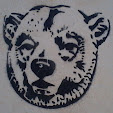One of those occasional visits to the
commoner makes brings us back to Atlantic.
Although we are looking at the 'HO' set, they (the ancients) all had the 1:32nd
scale sets painted-up as artwork, except the Trojans, who came a bit
later (1981/2'ish) and if you're a 1:32nd scale-only fan, just get closer to
the screen and imagine they're bigger for the rest of the post!
Came in several shades of orange-to-flesh
coloured polyethylene and had some problematical, fiddly bits, which were
probably pantographed down from 1:32nd scale, where they wouldn't have been
troublesome at all!
A four-horse, aerodynamic sports model with
Carlos Fandango extra-wide racingwheels and Triumph-Spitfire
quick-release hubs, she was a little dinger, a peach, a pearl - no bloody good for
fighting in a mountainous environment, but hey; she looks the business popping "darn the Spar for milk"!
Rear of the smallest box (1806),
you normally got two complete units, but sometimes you got four, someone in the
factory hadn't read the packing instructions! Another slight problem is getting
both crew to hold the grab-handles (without glue or trimming/removing the
bases) and - again - I suspect something which was not a worry for those with
the bigger figures - as can be seen from the artwork.
If you did keep it in the Greek army, it
was best to use the archer from the Infantry set, still anachronistic, but
slightly less so!
The fiddly-bits! The wheel-hubs are
illustrated without the 'wings', but they look better for them as they can be
the blades used on Persian chariots, when you transfer them to the Persian army
under lend-lease, to get some slightly more realistic service out of them!
The hubs also tend to be flashy or lumpy
and one has the mounting-hole off-centre! The driver's whip and the eagle
finial/ram from the horses' yolk-beam are also easy to lose.
Interestingly, both the instructions and
the painted 1:32nd scale set have no wings on the hubs, but I'm pretty sure
they did get them on the production release, so they must have proved
problematical - even in the larger size - at the pre-production stage.
I noticed that another issue, as well as
being a lighter brown, has a French postal code added to the
disclaimers/consumer-information panel, does this help date the sets?
I
remember getting my first 'late type' graphics' boxes of Atlantic (WWII and Ancients) in around 1977/78 in Germany and by 1981 Concord,
Beatties and Tangley round-here had piles of them,
literally piles! The French adopted these five-figure codes in 1972 which is
much earlier so it may be the printer just left it of the other box by accident?
I loved these back in the day, far preferred
them to the chunky Roman one, and I had two, painted-up, with 8 cavalry (from
the larger combined set) and a pair of Airfix
Roman chariots (along with the muck-cart!) as the 'flying wing' of my
Greco-Roman army, which was actually supposed to be 'Etruscan' . . . unless it
was invading Britain, then it became Caesar's rather-camp legion!








No comments:
Post a Comment